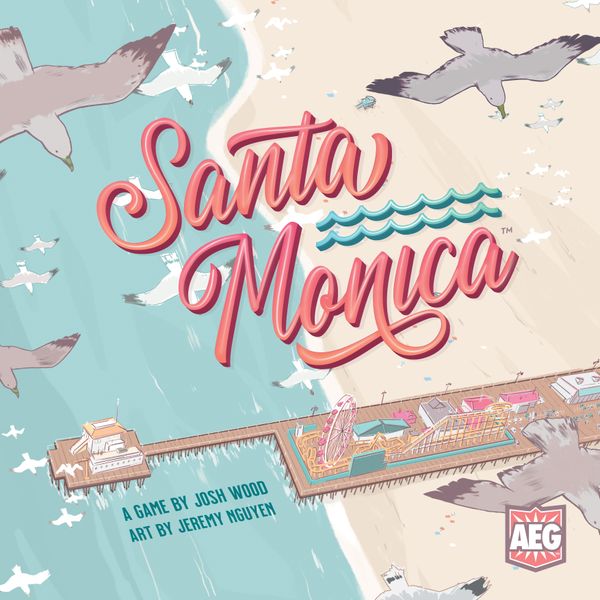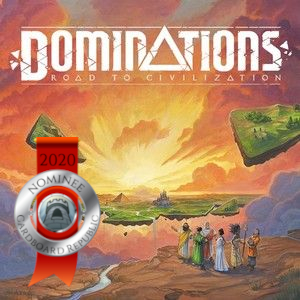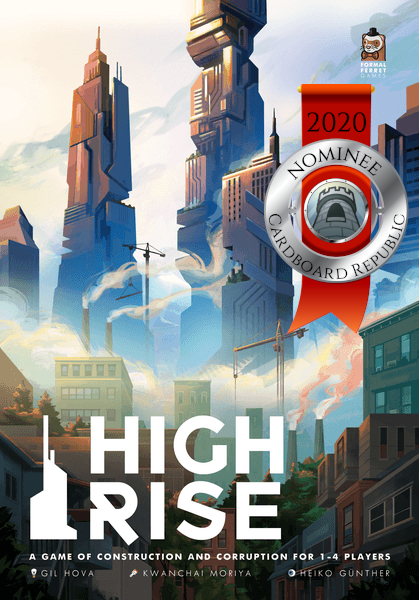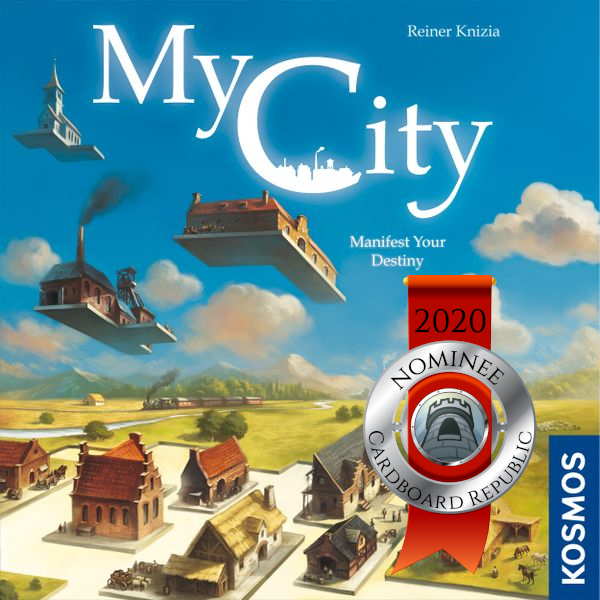The Cardboard Republic has rolled out the annual Laurels of the Republic awards, celebrating the best new games released in 2020 for each of the gamer archetypes. What follows are the finalists for one of those groups.
 Whether it’s amassing the largest armies, hoarding the most gold, or building the best village, Architects are always on the lookout to expand their sphere of influence as much as possible. These world builders thrive on games where they feel the game has a point and that the best way to secure victory has more options than simply cracking skulls. Careful, methodical, and always looking to trade short term goals for long term opportunities, games of this nature reward strategy, persistence, and a sense of progression more than anything else.
Whether it’s amassing the largest armies, hoarding the most gold, or building the best village, Architects are always on the lookout to expand their sphere of influence as much as possible. These world builders thrive on games where they feel the game has a point and that the best way to secure victory has more options than simply cracking skulls. Careful, methodical, and always looking to trade short term goals for long term opportunities, games of this nature reward strategy, persistence, and a sense of progression more than anything else.
And with that, here are The 2020 Laurel Finalists for Architects:
Honorable Mention: Santa Monica
Publisher: Alderac Entertainment Group | Players: 2-4| Play Time: 30-45 Minutes

Of all the motivating factors in what Architects crave in a game, the central tenant binding the rest together is that aforementioned sense of progression. Whether it’s flipping over terrain tiles, upgrading the efficiency of your factory, or laying the capstone to your newest architectural feat, the feeling that you are advancing something demonstrably purposeful is paramount. Particularly if doing so is favorable to you.
While that often translates into a predilection for slightly longer, more involved games, that isn’t a requirement. If done well, games with lighter and simpler pedigrees are fully capable of eliciting that same appreciation. Cue the splendidly succinct Santa Monica – a light and casual tableau game about fashioning your own southern California beachfront neighborhood.
Look brah, 2020 was a hell of a year. Anything that helped people add some chill and calm to their day was welcomed. And in that Santa Monica was a welcomed respite.
In Santa Monica you are overseeing the development of your own little slice of the Pacific. Your goal is to draft a series of land cards to slot into your tableau, each depicting some combination of pristine beaches and sanguine boardwalks. The catch is that you also must decide what kind of beachfront community it is you’re trying to cultivate, exactly.
Beyond the natural features to focus on, cards offer an array of effects, including methods to score VP and depositing meeples into your burgeoning block party. Some selection strategies cater to having a thumping city scene; others benefit for leaving the space as undisturbed as possible. As straightforward as selecting and placing a card is, there’s a decent number of small but worthwhile decisions to consider.
This gameplay appeal is bolstered from a palpable visual appreciation as you grow your micro-city. With a simple, inviting art style and the interconnected way cards create a sweeping panoramic shot, it’s hard at game’s end not to step back and appreciate your newly minted community.
It may not be as deep as games Architects usually plunge into, but Santa Monica assuredly scratches that city-building itch when something more expansive isn’t an option – such as, say, much of the last year. It’s accessible, concise, visually stimulating, and manages to capture the heart of what world builders love on a small scale, making it an easy game to shore up their appeal.
The Nominees

Number Five: Dominations: Road to Civilization
Publisher: Holy Grail Games / Luma Games | Players: 2-4 | Play Time: 75-120 Minutes
First off, kudos to Dominations for making decent use out of the triangle-shaped triomino. We’re not quite sure when or how it became the black sheep of the tile-laying polyomino family, but even a cursory glance reveals that it’s not nearly prevalent as one may think. Dominations, on the other hand, gleefully takes the idea and runs with it as the rather elegant resource-gathering foundation to its surprisingly casual civ-building premise.
A 2019 Kickstarter fulfilled in 2020, Dominations is a fairly straightforward game where players loosely take the reins of a historic society. Your goal over the course of this more passive-focused, tableau-based civ game isn’t to take over the board or conquer your enemies insomuch as it is about building up points and influence by demonstrating your ability to invest in technologies, erect cities, and contribute to some of the classical era’s most great cultural and architectural marvels. Instead, as this category group will certainly appreciate, competition in this setting is based around the efficiency in growing one’s empire rather than the ability to flex its muscle.
Played out over 3 eras of 5 turns each, the flow to Dominations is pleasantly concise and revolves primarily around color matching and modest resource management. Turns consist of placing a triomino from your hand to the board that helps generate you resource points by lining up colored gems depicted on them. These colors represent core pillars of civilization such as trade and government. These resources are subsequently used over the rest of the era to construct cities, monuments, or inventing specific technologies to your tableau. Crafting new inventions and ideas, however, comes with its own challenge, as each must be added to your tableau in such a way as to match up similarly colored nodes.
Though more abstracted and slightly less interactive than other civ-building games, Dominations’ puzzle-like nature nevertheless has a number of interwoven variables to consider over the game’s scant-feeling 15 turns. Over three eras you must continually juggle your ability to generate resources, create technologies to bolster your burgeoning empire’s efficiencies, and try to satisfy the end-game desires of your people. But with an almost exclusive focus on your own progress and a tangible sense of being rewarded for your optimization capabilities, Dominations is a laid-back civ game simply built for Architects to appreciate.
Number Four: High Rise
Publisher: Formal Ferret Games | Players: 1-4 | Play Time: 100-150 Minutes
Over the last few years, a captivating story emerged about a highly corrupt real estate developer and how their ambitious, power-hungry decisions completely warped their city’s day-to-day operations.
No, not him. Definitely not him. No one needs to talk about him.
That story is High Rise: the city-building game that almost wasn’t. Launched as a Kickstarter in 2019, canceled, restructured, and relaunched, there was a brief period of real concern the game would never see reality. Fortunately, such a travesty never occurred. Which means we are all now able to settle into a decadent game where…we’re all ambitious, slightly corrupt real estate developers?
Wait…
Yes, that is the central conceit to High Rise, all bundled up into a strategic, calculating, and tightly woven experience best described as Tokaido if every character were a member of the Bluth family. As a bunch of Big City moguls, players have blown into town looking to get as many of their buildings constructed as possible. With deep pockets, few scruples, and little cares about objections from Jared on the local co-op board, your goal cross three rounds is to erect increasingly taller buildings, outpace the competition, and generate the most VP. So long as it’s entirely legal.
Well, mostly.
Usually.
Stop asking questions.
Each round constitutes a trip around the board, in which players can take nearly any unoccupied space ahead of them, with the player furthest back going next. Most spaces represent building tenants and present an extensive collection of ability tiles randomized from one game to the next. Actions range from simple resource gathering to highly specialized effects.
Creating buildings, however, is at the heart of your amoral enterprise, each providing you VP and is attached to an action space Monopoly style – giving you kickbacks rent if others later use that space. Such buildings over time also lead to a stunning emergent table presence as increasingly taller skyscrapers slowly dominate both the skyline and what’s left of city hall’s morals.
High Rise is a highly variable, highly replayable game that rewards you for outmaneuvering and out-building your opponents – even if that means getting your hands a little dirty to get things done. At its spire-filled peak, High Rise is an experience in which construction, progress, and success are heavily intertwined. And that’s a blueprint nearly any Architect can appreciate.
Number Three: My City
Publisher: KOSMOS | Players: 2-4 | Play Time: 30 Minutes
It’s understandable to wonder why precisely a game like My City became one of the standout titles of 2020. After all, 30 minute polyomino placement games are not new. Legacy games are not new. Simultaneous turn-taking is not new. And designer Reiner Knizia (yes, that Knizia) is one of the most prolific game designers of all time with, quite literally, hundreds of games to his name. You could even play it once and not fully be convinced of its deservedly widespread acclaim.
But then you play it a second time. And a third. And a fourth. And suddenly it becomes very clear what makes this tile-laying game so special.
Conceptually, My City is pretty straightforward – think Sim City meet Tetris. Though the entire campaign is played out over 24 sessions, with each incrementally adding or modifying various rules, features, and VP goals as the city progresses from the medieval to industrial eras, the core flow of the game remains the same. Each playthrough has you deliberately attempting to cover (or not cover) areas of your board with building tiles of various colors and sizes. How and where you place your buildings in relation to other buildings or terrain features generates you VP in a litany of ways. Turns are simultaneous by revealing a card from a central deck, flip-and-write style, stipulating which building you must add that turn. Once everyone either can’t or doesn’t want to construct anymore, it’s hammers down. Points are tallied, a winner declared, and permanent legacy elements kick in.
Then wipe your buildings, rinse, and repeat.
My City is laudable for successfully implementing a simple family-weight legacy game that’s neither daunting nor cumbersome while also being a champion example of how iteration over ideation done right can nevertheless create a wholly new experience. But most of all is the gratifying way it constructs a twofold sense you are building towards something concrete with your efforts – both within each game as well as the larger campaign.
My City may be the lightest game on this list, but that only further underscores just how well-constructed this city builder is and why Architects have no problem settling into this enticing Euclidean playground.
Number Two: Beyond the Sun
Publisher: Rio Grande Games | Players: 2-4 | Play Time: 60-120 Minutes
Part of the indelible and unending quality to science fiction is its twofold capacity serving as a revelatory mirror to the sociocultural issues of the times it’s written for while also conjuring vast, imaginative possible futures that may await us.
Which if the genre has anything to say about it, that means we’re in real trouble.
One of the reasons Star Trek maintains such a lasting appeal is because while its humans have definitely gone through some stuff, the future more or less turns out for the better. But when it comes to the future of humanity, Earth, or both, Star Trek is very much the optimistic relative at the dystopian grimdark sci-fi family meetup.
Like so, so much trouble guys.
While the appropriately named Beyond the Sun certainly has aspirational potential, you know where this is going. Set in the mid 23rd century and recognizing that Earth was becoming increasingly uninhabitable, the global community pooled its research into getting off this battered blue marble, culminating in hyperspace travel. But because humans are still humans, competing factions emerged to develop new advantages and expand their influence into the cosmos.
For the game itself, however, its fate is much brighter.
Released in late 2020, Beyond the Sun flew through its initial print run on Ludicrous Speed. Though it bears the telltale traits of a classic space-based civilization game via controlling sectors of space and colonizing new planets, the core motivation of BTS resides with its branching and rewarding tech tree advancement. Over a series of rounds you must mindfully balance your (often limited) production of raw materials and population to expand in space against the ever-driving desire to invent new technologies to further fuel said ambitions. Both lanes generate much vaunted VP. Yet while wresting control of planets from one another can be prudent and advantageous, it is only through pushing technological breakthroughs do you gain access to new and better action choices. In Beyond the Sun, teching is the lifeblood of opportunity and success.
Beyond the Sun boasts dynamic tech tree evolution propelled by the strategic machinations of the players alongside the freedom to pursue a handful of variable endgame achievements, all while constraining itself to elements of expansion and development. For Architects, the most alluring games are those that focus not just on building but building with a purpose, and this stellar title delivers.
This is reinforced all the more given that despite its late year release Beyond the Sun rocketed itself all the way to the runner-up position on this year’s list. It was even orbiting the top spot. But that one involves an engine of a very different kind…
The Winner
2020 Architect Laurel – Empyreal: Spells & Steam
Publisher: Level 99 Games | Players: 2-6 | Play Time: 30-90 Minutes
One of the most entertaining parts of the Laurel vetting process for us is watching how the finalists for each category materialize, from Kickstarted smash hits to late year sleepers. This is especially true given that you never know exactly where the year’s releases will take you, with some categories having a windfall of possibilities and others end up being pleasant but completely unforeseen surprises. Without question, however, we do invariably come across a handful of games every year early on that we know immediately are destined to be among the nominees.
Empyreal was one of those games.
From the outset Empyreal energetically and effortlessly conjures up so many of the elements that Architects desire in a board game. Before the start whistle is blown its evident that this is a route-building rail game that celebrates growth and expansion at every curve. And while its finish line may be unceremoniously linear, it puts you squarely behind the controls on how to develop the engine that gets you there – in more ways than one.
Set in Level 99’s expansive fantasy-style World of Indines (i.e Argent, BattleCON), Empyreal: Spells & Steam is a bright and vibrant game about building up magical railways and using those connections to deliver goods along your route to cities for important contracts. If you’d ever wondered what the Final Fantasy equivalent of the Hogwarts Express was like, this game has you covered.
In this magic-meets-industrialization setting, each player commands a new railway company competing to bring goods to market. Chugging along over a series of turns, Empyeal focuses heavily on its pick-up-and-deliver mission but offers a dizzying assortment of options to accomplish this. Turns involve selecting an action column on your board and then activating magical railcards beneath, generally to build new rail track. The more railcards you acquire, the more powerful turns become as you expand across the board to connect your trains from spaces with specific goods on them to the cities looking to obtain them. Succeeding at claiming the all-important delivery contracts is as much about being efficient as it is about being timely and avoiding competition.
As befitting its theme, Empyreal has ample different levers to pull and paths to take as you try to become Indines’ new railway magnate. With highly variable gameplay, extensive decision-making flexibility, and an appreciable sense that you’re building with a purpose, Empyreal is precisely the kind of engaging route builder Architects will get steamed up over. Which is why this engine-building engine builder rode all the way to earning 2020’s top spot.
![]()
Empyreal Contest!
We thought about different ways to highlight how great the winning title of the Architect Laurel is. Given the game’s focus on the magical transports and what amounts to a fairly eccentric logistics network, we really strained our brains trying to come up with a way that would capture that feeling in the real world that wouldn’t have us run afoul of the Federal Railroad Administration. (Let’s just say that we’ve had some dealings with the Department of Transportation before and we’d really prefer not to rile them up again.) Which is a shame really, because the idea of showing a lucky group the American countryside from the vantage of an open-air freight car would have been a trip to remember. We also considered taking things inside and using a private car to ride the rails and play board games for a couple days, but apparently they don’t let you keep private cars if you don’t make payments on them. You win this round Amtrak. Finally, we considered doing March Madness style elimination contest pitting a few dozen train games against one another, but the debates over 18XX titles alone would probably send us into July and we’re already behind schedule. Which is not something the railroads are fond of. So we decided to ditch all of those entirely just focus on the game by raffling off a copy instead.
Anyway, let’s get to it!
That’s right! Enter below for your chance at your very own copy of Empyreal: Spells & Steam!
Note: In honor of their award recognition, Level 99 Games has kindly provided a copy of this game for giveaway purposes. However, due to it currently being between print runs, the winner will initially receive a pledged copy from the publisher and have the game sent to them once available again.
![]()
Be sure to check out the 2020 Laurel Award pages for the other archetypes once they go live!












